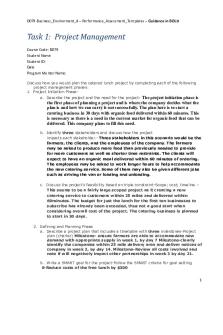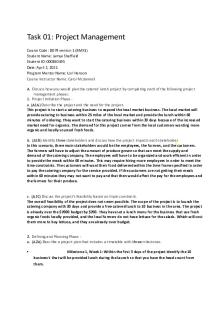D079 WING Jenna BXM1 TASK 1 PDF

| Title | D079 WING Jenna BXM1 TASK 1 |
|---|---|
| Author | Deana Schwilke Abel |
| Course | Business Environment Applications I: Business Structures and Legal Environment |
| Institution | Western Governors University |
| Pages | 3 |
| File Size | 60.1 KB |
| File Type | |
| Total Downloads | 34 |
| Total Views | 132 |
Summary
Download D079 WING Jenna BXM1 TASK 1 PDF
Description
Jenna Wing [email protected] D079: BXM1 – Task 1
Managing a Project 1A.
There recently has been a demand outside our stores for locally sourced organic food to answer this demand we are starting a project to open a catering business that provides just that within a 25-mile radius of our downtown location. In our business we have the farmers associated with the four-farming community, customers, and the owner representing our stakeholders in this project.
1B.
Identify three stakeholders: i. The owner – impacted by the failure or success of the project, banking on the success or risk losing/wasting time and money on a failed venture. ii. Local farmers – impacted by the fact the grow and supply our food. If the catering business does poorly this could negatively impact the farmers. iii. The Customers – impacted by availability of lunches which lack of could lead to the needs of the customers being unfulfilled.
1C.
This project is feasible based on scope, cost, and time – considering the company already has their market, by utilizing materials from the stores that’s available, it is in scope. The owner has already surpassed the launch budget by 10%, while this can be mitigated, still is a potential risk. There is a timeline of launching the catering company on the stores 10-year anniversary, turning a profit their first year – which considering there is this much demand seems to be an attainable timeline however there may be an issue with having their first catering event in two weeks and not being able to provide the organic lettuce as promised.
2A.
From what we read in the scenario, the milestones we must deliver as a company in starting our new catering company, are to get our customers their food within 60 minutes from receiving their order, keep our delivery area to a maximum of a 25 mile radius of downtown, and to turn a profit within the first year.
2B.
Specific – with an increasing demand from local consumers to have more locally sourced organic foods, the owner of a market wants to create a catering business serving just that for costumers living within a 25-mile radius from their downtown location. Measurable – The 60-minute delivery window to customer from time of receipt of order the company is striving towards Achievable – Utilizing the delivery van to prepare, package, and deliver consistent, quality meals to build a loyal customer base. Relevant – Delivering catered lunches to the ballroom by 12pm on the selected day
Jenna Wing [email protected] D079: BXM1 – Task 1 Time – Delivering to customers withing 60-minutes, turning a profit in less than the first year, and the offer of free catered lunches to the first 10 subscribers at the opening in 30 days. 2C.
One potential risk the company is taking by opening in 30 days is the shortage of lettuce. Being that it is a staple ingredient, the catering company should work their launch around the farmers harvest of lettuce, so they make sure to have plenty for a successful launch or find additional farmers. Another risk, is with the owner already being over budget on the launch, offering the first 10 subscribers’ free food will make us even more over budget. Instead, we should offer a percentage off or buy one get one free promotion, so we don’t hinder our budget even more. While two was asked, a third risk they take is limiting their delivery area to a 25-mile radius. It would help the business to be able to expand into other markets or at least have a plan to, including buying more delivery trucks to reach different areas.
3A.
To reduce additional expenses, we could implement a rotating menu that is created based on what the cheapest available produce is during that season to substitute or replace lettuce. The owner could also seek out alternative vendors to lower costs.
3B.
We will need a contingency plan for when the owner runs out of lettuce two weeks before opening that gives us access to additional organic lettuce vendors, instead of just one, so we don’t run into a scheduling conflict with our launch because we are short on lettuce. If finding other growers is an issue, we can go with what’s mentioned in 3A about substituting other items for lettuce.
4.
With a defined timeline and budget, the owner is on track to having a successful launch, if, he follows his plan to a T. If they don’t, they’ll face scheduling conflicts and budget constraints potentially affecting the outcome of their launch – often known as scope creep, this is when a project becomes uncontrollable due to negative changes happening. The owner’s goal will be much more attainable if he effectively manages these changes as they surface. One example of a scope creep in the scenario is the risk of not being able to deliver on the “First 10 subscribers get a free lunch” promise due to not finding alternative solutions to the lettuce issue. This will be a negative thing for customers, and they may not come back knowing the first time they came you were already out of a staple ingredient.
5.
One major way to change this project plan, would be to not be in such a rush to open in 30-days. The project should have a longer timeline to be able ensure the launch is most successful and we have the lettuce issue handled. We also need to make changes to the promotion – with it being worded towards subscribers instead of individuals, we need to put a limit on the promo so we aren’t giving away hundreds of dollars of food away, this should be changed to first meal free or something similar.
Jenna Wing [email protected] D079: BXM1 – Task 1...
Similar Free PDFs

D079 WING Jenna BXM1 TASK 1
- 3 Pages

Task d079 copy - Task 1
- 3 Pages

D079 - Task 2 Final
- 3 Pages

Lorna Wing - Apuntes 1
- 2 Pages

Wing and Tail Design 1 1
- 19 Pages

PCE Task 1 - Task 1
- 2 Pages

Task 1 - SUS101 Task 1
- 2 Pages

Qht1 task 1 - Task 1
- 3 Pages

QBM1 Task 1 - Task 1
- 5 Pages

C365 - Task 1 - Task 1
- 4 Pages

Task 1 - C226 Task 1
- 11 Pages

C304 Task 1 - TASK 1
- 16 Pages

DIT1 TASK 1 - Task 1
- 4 Pages

D078 Task 1 - task 1
- 2 Pages
Popular Institutions
- Tinajero National High School - Annex
- Politeknik Caltex Riau
- Yokohama City University
- SGT University
- University of Al-Qadisiyah
- Divine Word College of Vigan
- Techniek College Rotterdam
- Universidade de Santiago
- Universiti Teknologi MARA Cawangan Johor Kampus Pasir Gudang
- Poltekkes Kemenkes Yogyakarta
- Baguio City National High School
- Colegio san marcos
- preparatoria uno
- Centro de Bachillerato Tecnológico Industrial y de Servicios No. 107
- Dalian Maritime University
- Quang Trung Secondary School
- Colegio Tecnológico en Informática
- Corporación Regional de Educación Superior
- Grupo CEDVA
- Dar Al Uloom University
- Centro de Estudios Preuniversitarios de la Universidad Nacional de Ingeniería
- 上智大学
- Aakash International School, Nuna Majara
- San Felipe Neri Catholic School
- Kang Chiao International School - New Taipei City
- Misamis Occidental National High School
- Institución Educativa Escuela Normal Juan Ladrilleros
- Kolehiyo ng Pantukan
- Batanes State College
- Instituto Continental
- Sekolah Menengah Kejuruan Kesehatan Kaltara (Tarakan)
- Colegio de La Inmaculada Concepcion - Cebu

